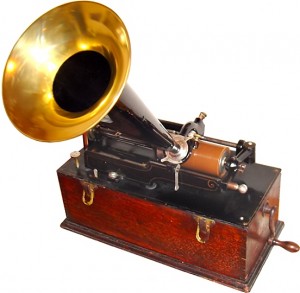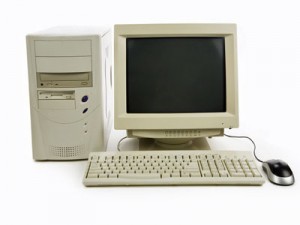Compiling or “Comping” takes is relatively new to sound recording. With the increased ability of technology has come the increased desire to comp with excruciating attention to detail, sometimes all the way down to a syllable or note, to create “The Perfect Take.”
The Acoustic and Electrical Eras (1877-1945)
When audio recording was first introduced, it was an entirely mechanical process. Comping did not exist. In fact, neither did mixing as we know it. Everything was recorded in one take, and level adjustments were made by moving musicians closer to or farther from the horn–essentially the microphone of its time.
In the primitive stages of this recording format, it was not uncommon to have copies of the same record that sounded entirely different. This was because if a band wanted to release 1,000 copies of a song, they would have to record it 1,000 different times, each take resulting in its own uniquely-performed copy.
The Magnetic Era (1945 to 1975)
Although tape offers a unique sonic quality, digital recording has many advantages over tape, not the least of which is the ability to comp quickly and simply.
Until multitrack tape recorders became common, comping was more like editing – a manual, mechanical, unforgiving, and tedious task involving a razor blade, a grease pencil, and a highly honed skillset. Crossfades were made between comped takes by cutting the tape at an angle–the more horizontal the angle, the slower the fade. After cutting the tape, there was no undo button to repair any mistakes. I can’t help but wonder how many songs had to be recorded over again due to the slightest mistakes in splicing…
Multitrack tape helped, but it was still an awkward process of hoping you had enough open tracks and then soloing, punching, erasing, and muting while you bounced sections of tracks down to another open track – with a generation loss and other complications. Or you could try to slave a second machine to gain more tracks, but that could also become a logistical nightmare.
To see just how far we’ve come, here’s a video in which an engineer makes just one tape edit in about a 5-minute timeframe:
The Early Digital Era (1975 – c. 2010)
Many engineers frustrated by the limitations of analog tape were quick to embrace digital recording. The technology evolved extremely quickly during this time. Digital multitrack tape become commonplace in the early 90s, right around the same time as the first mass-market DAWs. Before the year 2000, hit songs were being recorded, edited, and mixed entirely “in-the-box.”
As late as 2010, around the time of SONAR 8.5, comping was still a good deal slower than it is today. Take lanes were readily available, but the engineer still had to drag audio around, manually manipulating the start and end points of every clip to make them fit into one single composite take.
The Modern Digital Era (c. 2010 – Present)
The SONAR X-series introduced Speed Comping, an aptly-named feature which allows creating comped takes in as little as a single click per edit. You want the first half of the Verse from Take 1, the second half of the Verse from Take 4, and the Chorus from Take 2? No problem–highlight those parts, and you’re done!

Producers and engineers across all genres have relied on comping at some point or another. Here are a few scenarios:
- When producing for a label that expects a flawless, pristine performance, there can be no mistakes, no drifting from the beat, and every lyric must be pronounced cleanly and audibly. If the singer has to do 100 takes just to nail every line in the first verse, they’re probably going to end up exhausted and their performance will suffer. However, they may have performed each individual line perfectly at some point in the first dozen takes. Use comping to construct the perfect take by combining these together. Ultimately, 75 fewer takes is going to make for a much happier artist, and it’s going to save you time (aka money).
- You’re working with a band, maybe your own, that values achieving a good groove and feel more than grid-like rhythmic and tonal perfection. This is a great opportunity to combine cut/paste with comping. For example if the chorus in one part of the song had a great drum/bass groove, copy that for the other chorus, then comp the vocals, guitars, or whatever to it. Even though there are two copied parts, they’ll sound different because of the comped overdubs. Comping takes the pressure off: Go ahead, try to hit that high note you normally miss, add an extra layer of emotion to the end of a phrase…take chances. You just might come up with some great, unexpected element that makes the track shine – but if you don’t, you have the security of knowing those other takes are available.
- You just recorded the best guitar solo since Eruption, but you bent the last note just a little bit too far, and your vibrato was rather weak. Play another take, focusing on your vibrato and perfecting that final bend. Blend the best parts of each take, then bask in your shredding glory.
Whatever your approach to music, comping is almost always going to be a part of your editing workflow, and you should never be intimidated by it. The ability to view Take Lanes side-by-side and perform edits with a single click of the mouse will provide you with the confidence and speed to do it, and do it right.
Comping Dos and Don’ts
DO listen to the edits you’ve made for continuity. If the singer sang right into the mic on one take but at an angle on another take, there may be a timbral mismatch.
DON’T overthink it. Remember, a song tells a story. If you chop it up into too many pieces, the story may be “perfect” but lose some of the emotional impact. Perfection isn’t everything, it’s one thing.
DO solo the final comped version and listen all the way through on headphones to catch any glitches, splice problems, or other gremlins that can creep into the process. Sometimes, edits can introduce noises, particularly where the clips intersect. A quick (~5ms) crossfade can usually tame these issues.
DON’T think you can comp a bad part into being a good one. If it takes a long time to do the comping, try re-recording the part. Hey, you have enough tracks!
DO try to do your comping in one session. It will be much easier to maintain a consistent tone and vibe among the various takes.
DON’T do a zillion takes–you’re just going to have to sort through them. Do a half-dozen takes or so. If you didn’t nail it with those parts, erase them and re-record new takes.
DO take notes when you’re recording (and don’t forget SONAR has multiple places where you can add notes). Writing it down now can save you from having to waste time searching for the right take later.
DON’T be afraid to commit. Once you’ve decided that you have a good comped part, bounce it and jettison the rest. You don’t need all that clutter and besides–if you played it once, you can play it again.


